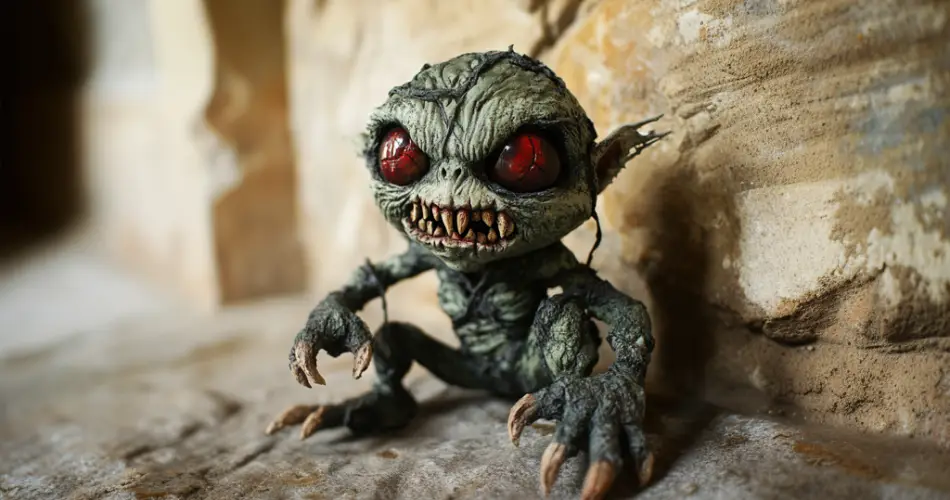In Southeast Asian folklore, the Toyol is a reanimated dead baby, particularly in Malaysia, Indonesia, Thailand, and Singapore. This mythical creature is known for its mischievous and sometimes malevolent behaviour.
It is typically depicted as a small child-life figure that helps its master with shady tasks such as theft, gambling manipulation, and sabotage. This creature can also be manipulated to cause harm to others.
Origin of the Toyol
The ancient creature is often described as the spirit of a deceased infant that has been reanimated through black magic. This reanimation is done by a shaman who is said to bind the spirit of the dead infant and force it to serve a master.
According to stories, the origin of the Toyol can be traced back to ancient pre-Islamic Arab civilizations. It is said that these ancient communities killed children on a large scale and buried them around the ancient city of Mecca. Some of these dead babies were reawakened with dark magic and used to steal from travelling merchants. However, with the arrival of Islam, the practice died out in the region.
Variations of the Toyol exist in various ancient cultures and civilizations. In ancient China, there was a creature called the Gui Zai, which literarily translates to ghost child. Another variation of the Toyol is the Kuman Thong and Kuman Ley, which are household divinities worshipped in Thailand.
How does the Toyol Look like
The Toyol maintains the physical appearance of a small child with grey or green skin. It also has large red eyes and sharp teeth. This creature is sometimes depicted with a bloated belly, symbolizing its undead nature.
Behaviour and Characteristics
Despite its small size, the Toyol is described as a very agile creature who can climb walls and pass through tight spaces. The primary purpose of this creature is to assist its master in carrying out tasks that are generally frowned upon by society. The most common of which is theft.
A Toyol is often sent to steal money, jewellery, or other valuables from unsuspecting victims. Due to its small size and supernatural abilities, the Toyol can easily sneak into homes undetected.
Aside from theft, the Toyol can be used to cause mischief or harm to enemies of its master. This includes causing illness, bad luck, or even accidents. However, the Toyol’s abilities are not unlimited.
Like normal children, the Toyol are easily distracted by shiny objects or toys; they are also afraid of their reflection in the mirror. It is generally believed that the Toyol is most effective in simple and straightforward tasks.
The Toyol is often passed from one generation to another, and the longer the creature spends in a household, the stronger it becomes.
How the Toyol is Maintained
Maintaining a Toyol requires continuous offerings and rituals. It is believed that the Toyol, like a child, must be cared for with specific items such as toys, sweets, and milk. Additionally, some believe that feeding the Toyol a few drops of the owner’s blood keeps it loyal and obedient. Failure to maintain the Toyol properly can lead to it becoming unruly or even turning against its owner.
Households with babies are advised to take special care as the Toyol can get jealous of the attention the new baby is receiving and attack the infant.
How to prevent the Toyol
It is believed that the Toyol can be prevented from carrying out its missions by keeping valuables close to mirrors. The Toyol is afraid of the mirror and will not steal any object placed around it. Also, leaving shiny objects around will distract the creature and cause it to forget its mission.
Cultural Significance and Modern Perceptions
The Toyol holds a significant place in Southeast Asian folklore, where it serves as a cautionary tale about the dangers of engaging in dark practices and the consequences of greed. Stories of the Toyol are often used to explain mysterious thefts or misfortunes within a community.
In contemporary society, the Toyol has also become a subject of popular culture, appearing in movies, television shows, and books. The 1984 movie Gremlins depicts this mythological creature.
Despite the modernization of Southeast Asian societies, the belief in Toyols persists, particularly among those who hold onto traditional spiritual practices. The Toyol remains a symbol of the moral and ethical dilemmas associated with the use of supernatural powers for personal gain.
